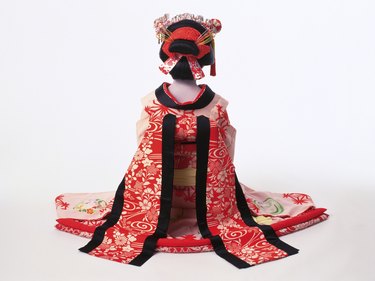Things You'll Need
Measuring tape
Pencil and notepad
Bamboo pole or wooden dowel
Screwdriver and screws
Rod hanger and 2 brackets
Wall anchors
Level, optional
Drill and bit
Small clothespins, optional

Kimonos can make striking wall displays, adding color and drama to a space while evoking a Japanese aesthetic. You can buy a kimono stand called an ikou, or iko, or a kimono hanger, but making your own kimono hanger allows you to create a custom display. Kimonos are often hung facing the wall, with the ends spread open and clipped to the sleeves to display the full range of colors and back details. If the front of the kimono has beautiful detail, you can hang it facing out instead, with the coordinating obi hanging underneath.
Preparation
Step 1
Spread the kimono out on a clean surface. Lay it out flat so the shoulders are straight across the top, and the sleeves and body stretch straight down. If you will be hanging the kimono face out, lay it face up and leave it straight. If you will be hanging it facing the wall, lay it face down and pull the ends of the front hem to touch the bottoms of the sleeves.
Video of the Day
Step 2
Measure the width across the shoulders, from sleeve edge to sleeve edge, and then add 2 inches. Write down the measurement. This will be the width for your bamboo pole or wooden dowel.
Step 3
Measure the length of the kimono, from the center of the neck to the bottom of the hem. Write down the measurement. This will determine how high you hang your kimono.
Step 4
Determine where to hang your kimono. Use the measurements to help you find an open wall space large enough for the display. The kimono should hang above furniture, rather than behind it, if possible.
Step 5
Purchase a bamboo pole or wooden dowel and have it cut to length. Most home improvement stores carry garden bamboo and will cut it for you. Get a piece about 1 1/4 inches in diameter, or use a wooden closet rod or dowel.
Hang the Pole
Step 1
Measure the wall where you plan to hang the kimono. Using the vertical length of the kimono, determine how high you want the center of the bar to be, and mark this spot with a pencil.
Step 2
Using the center point, measure out horizontally and mark the wall for the ends of the rod, which will be just outside the kimono sleeves. Use a level to ensure the points are straight, or measure down from the ceiling to each point to make them even. At either end, align the outside edge of the rod hanger bracket with your marks. Mark the hanging holes for the brackets for both sides.
Step 3
Use the drill and a small bit to drill pilot holes at the marks for the rod hangers. Insert wall anchors for the rod hanger brackets if there are no studs to support them. If there are studs, you can screw the rod hangers directly into the wall. Use the level or measure to double check height before hanging the second rod hanger bracket.
Step 4
Place the rod on the hangers and double check that it is level and secure.
Hang the Kimono
Step 1
Take the rod back down and slide the ends of the rod into the kimono sleeves, carefully centering the kimono on the rod.
Step 2
Place an obi on the rod underneath the kimono to add another layer of color and dimension to the display, if you're hanging the kimono face out. Arrange the obi so the most decorative side is facing out, framed by the kimono.
Step 3
Carefully place the rod, resting either end on the brackets just outside the sleeves. Arrange the kimono and obi so they're centered and hanging straight down from the rod. The kimono collar should be straight up in the center.
Step 4
Slide the kimono onto the rod and center it to hang the kimono facing the wall. Place the center ends of the rod on the two brackets, and carefully arrange the kimono so it hangs straight down from the rod. Reach underneath the left side and gently pull the left lower hem out to meet the inside bottom of the left sleeve. Use a clothespin to carefully clip the kimono in place, keeping the pin hidden against the wall. Repeat on the right side.
Tip
Hang the kimono on an interior wall if possible, especially in areas with damp climates.
Video of the Day